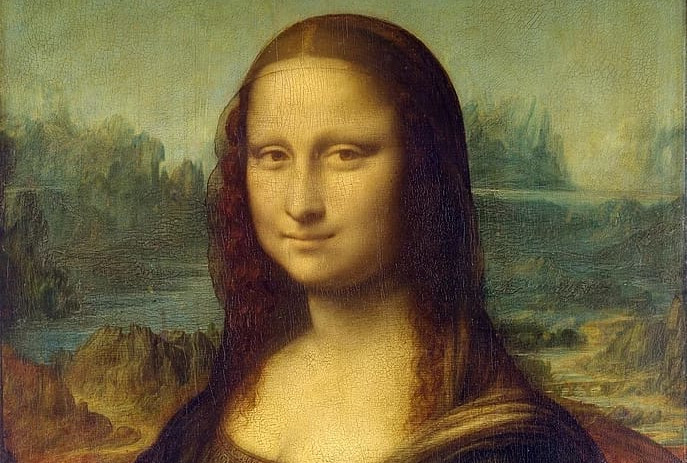Leonardo da Vinci, the oldest of the Italian High Renaissance artists, died five hundred years ago, on 2 May 1519.
Leonardo was born on 15 April 1452 near the village of Vinci, from which he takes his name. His mother, Caterina, the daughter of a poor farmer, worked as a servant. She was not married to Leonardo’s father, a professional notary, with whom Leonardo was living by 1457. He later lived with his paternal grandfather. It was during the seven years with his grandfather that Leonardo learnt to read, write, and calculate.
Leonardo’s grandfather died when the boy was twelve, at which time he returned to his father. As he was not the legitimate heir, Leonardo was not sent to further his education in a secondary school, and so he never learnt Latin, Greek, or higher mathematics; instead he took up an apprenticeship and ended up in the workshop of a master painter in Florence. This is where his career really began.
Florence in the fifteenth century, like much of Italy, was a violent place, where rival merchant dynasties fought each other for power. It was one of the largest cities in Europe, and it was the centre of the Italian Renaissance.
As a man of the people, rather than an aristocrat, all his life Leonardo had to seek employment with princes in order to earn an income. He designed weaponry for them, acted as a political adviser, designed costumes, and devised various entertainments, played music, and recited verse.
He was also a scientist. Modern science, based on experiment and experience, was emerging. Leonardo wrote in the Introduction to his Treatise on Painting: “To me it seems that those sciences are vain and full of error which are not born of experience, mother of all certainty, first-hand experience which in its origins, or means or end has passed through one of the five senses. And if we doubt the certainty of everything which passes through the senses, how much more ought we to doubt things contrary to these senses, such as the existence of God or of the soul or similar things over which there is always dispute and contention.”
He pioneered this empirical approach in his anatomical drawings, which gave him, for example, an understanding of the circulation of the blood centuries ahead of his time. Other interests included the cardiovascular system, the head, and the eye, with a realisation that light enters the brain through the eye—the opposite to contemporary medical thinking.
Visual records of dissections were rare at the time, and Leonardo’s drawings were unprecedented in their detail and accuracy. He composed these depictions at some considerable danger to himself: not only was he exposing himself to bacteria, he was also violating church law, with the threat of severe punishment.
He was also an architect and town planner. He was an engineer, who thought about linking rivers by means of canals, and came up with plans for building tunnels through mountains. He developed war machines as well. He discovered laws governing optics, light, and gravitation. He closely observed the flight of birds and made plans for building a flying apparatus.
Moreover, Leonardo was one of the first artists to make extensive use of paper. The demand for paper had increased dramatically following the invention of typesetting for the printing of books. Before this, writers and painters had used parchment. The arrival of cheaper paper meant that artists could draft and discard many ideas.
Another Renaissance innovation that Leonardo made use of was oil paint, rather than the previously favoured fast-drying egg tempera.
But of course Leonardo is best known for his paintings, and in particular La Gioconda, known in English as Mona Lisa. The portrait is not very large: 77 × 53 cm, painted on poplar wood.
With his portrait of Ginevra de’ Benci in the mid-1470s Leonardo broke with the traditional genre of female portraiture in Italy. The sitter is not painted in profile, as was then standard, but, like a man, in a three-quarter pose. She is capable and intelligent, and is painted outdoors. This is also true for La Gioconda. However, comparing the features of the two women, it becomes apparent that by the time he painted Mona Lisa he had a far more developed understanding of anatomy.
La Gioconda is a woman of means. Slight hints of columns on the edges of the painting and a balustrade indicate an aristocratic country villa, as does the elevated balcony. This house overlooks a landscape of water and the mountains, emphasised by towering clouds. A road to the viewer’s left and a bridge across a river on the right mirroring the road indicate human activity, though no other human form is present. The suggestion is that the countryside belongs to this woman’s family.
Different from his portraits of Ginevra de’ Benci and Cecilia Gallerani, Leonardo now softens the facial outlines and contours, using his technique of sfumato (smokiness). Slower-drying oil paint enabled him to blur edges and create a lack of definition that suggests movement. Similarly, the landscape is hazy.
Leonardo developed this technique through close observation and scientific thinking about how the eye perceives things, based on the filtration of sunlight through particles in the air, affecting the reflection of light by objects. Sfumato enabled him to produce a vivid, apparently moving image of a living thing—person, plant, or animal. His treatment of atmospheric light creates an impression of infinite changeability.
In the case of the Mona Lisa this movement and energy is particularly apparent in the facial muscles. And here lies the secret of her smile: sfumato shading and slight blurring create an uncertainty round her mouth and lips, a subtle transition between smile and no smile. Leonardo’s smokiness captures supremely and scientifically the way the eye sees living nature in continual movement and change; we might call it the dialectics of nature.
Sfumato is used for everything around the figure. Not only could she be “living” but so could the nature around her. Her image and the countryside in the background are not “photographic” images: they are depicted as the human eye perceives them, a person and external nature as seen by a human being. This is a truly revolutionary standpoint.
The painting enacts everything that Leonardo knew about life—as an engineer, a scientist, and an artist. It expresses the very essence of Leonardo’s dialectical understanding, all his insights into nature and humankind. It captures perfectly the spirit of the High Renaissance.






